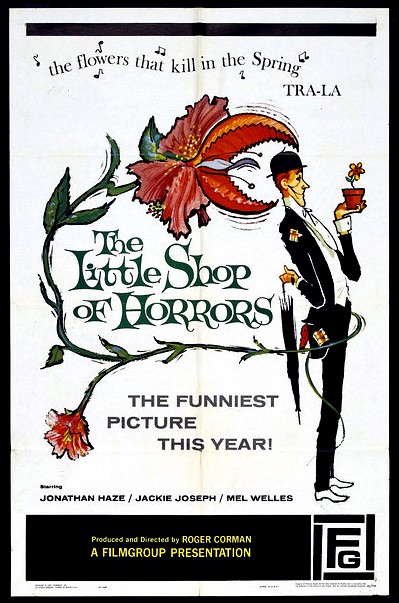Previous FilmThe Leopard Man
Next FilmThe Loch Ness Horror
The Little Shop Of Horrors 1960
 | A clumsy young man nurtures a plant and discovers that it's carnivorous, forcing him to kill to feed it. |
The Cast
| Jonathan Haze | - | Seymour Krelborn |
| Jackie Joseph | - | Audrey Fulquard |
| Mel Welles | - | Gravis Mushnick |
| Dick Miller | - | Fouch |
| Myrtle Vail | - | Winifred Krelborn |
| Karyn Kupcinet | - | Shirley |
| Toby Michaels | - | Shirley's Friend |
| Leola Wendorff | - | Mrs. Shiva |
Film Trivia
Made in 2-1/2 days on a budget of twenty-two thousand five hundred dollars.
When asked where Seymour got the plant, he replies that the seeds were obtained by a Japanese gardener who found the bulb in a "plantation next to a cranberry farm." This joke is lost on modern audiences. In 1959, it was announced that cranberry crops were tainted with traces of the herbicide aminotriazole, and as a result, cranberry sales plummeted.
A young Jack Nicholson has only a small part as Farb's masochistic patient, Wilbur Force. Later, however, as the actor's career began to take off, he was prominently featured on the home-video releases to help generate interest in the film.
Charles B. Griffith stood off-screen providing the voice of Audrey Junior as a reference for the actors and actresses. The voice of the plant was supposed to be dubbed in by another actor in post-production, but Griffith's vocalization of the plant got laughs, and Producer and Director Roger Corman was notoriously cheap, so his voice remained in the final print of the film.
The shooting schedule for this film was two days and one night, because Roger Corman had made a bet that he could make a movie in two days. Charles B. Griffith took a little more than that to write it.
The name of the character "Siddie Shiva" is a pun from the phrase "sitting Shiva", a Jewish funerary ritual, as well as a direct reference to her unlucky and constantly expiring relatives.
Much of the comical dialogue between Mel Welles and Dick Miller was ad-libbed.
Dick Miller genuinely ate flowers for this movie.
Charles B. Griffith put several of his relatives in the film; Myrtle Vail, "Grandmother" Myrt, for example, is actually his grandmother, and the hobo who Dr. Farb tortures in his office is Griffith's father. He also placed several of his relatives in crowd scenes. The bums in the background of the street shots on Skid Row are real transients, however, and were filmed in the actual skid row area of Los Angeles, California.
Roger Corman would shoot scenes with two cameras rolling at once whilst placed at different angles. He rarely shot re-takes, and spent little time on lighting scenes.
Charles B. Griffith not only wrote most of the screenplay, he also appears (uncredited) as the screaming dental patient who runs out of Dr. Farb's office, the burglar who breaks into the flower shop, and the voice of Audrey Junior.
Although the film is legendary for having been shot in only two days, Jonathan Haze recalled in "The Little Shop of Horrors Book" that he was called back several weeks later for re-shoots.
Remade as a successful stage musical that was later adapted into the film Little Shop of Horrors (1986). The success of the musical led to the animated series Little Shop (1991), which director, Roger Corman served as a consultant on.
Jack Nicholson's first horror movie.
The manager of Producer's Studio informed Roger Corman that a large office set had been constructed for a production that was about to wrap. Corman arranged to use the standing set, redressed, as the main set of this film.
Dick Miller was originally offered the role of Seymour Krelboin, but declined it in favor of the flower-eating Mr. Fouch instead.
The first collaboration between Roger Corman and Jack Nicholson. Corman would go on to direct Nicholson in four more movies: The Raven (1963), The Terror (1963), The St. Valentine's Day Massacre (1967), and The Trip (1967).
Mr. Mushnik says that he is going to stay at the store overnight to take care of "that meshugganah plant". "Meshugganah" is a Yiddish word meaning "crazy".
The film was originally released on a double feature with Black Sunday (1960), and later on a double bill with Last Woman on Earth (1960).
In 1995, the movie was adapted as a 3-issue comic book series, which was released by Roger Corman's Cosmic Comics. The last two issues included interviews with stars Jonathan Haze and Mel Welles.
Opening credits: All events, characters, firms and institutions in this photoplay are fictional and any similarity to any persons, living or dead, or to any actual events, firms and institutions is coincidental and unintentional.